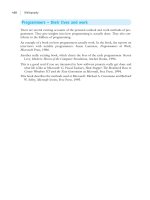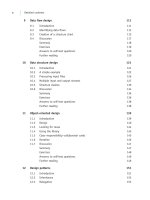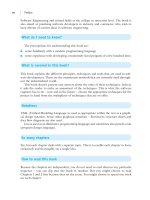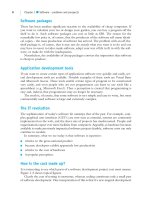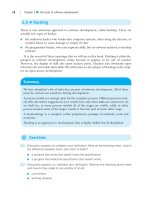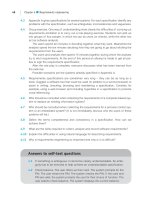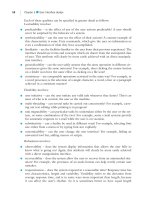Software Engineering For Students: A Programming Approach Part 7 pot
Bạn đang xem bản rút gọn của tài liệu. Xem và tải ngay bản đầy đủ của tài liệu tại đây (143.45 KB, 10 trang )
38 Chapter 4 ■ Requirements engineering
On the other hand, some people argue that it is impossible to divorce specification
and implementation. Indeed, in several major approaches to specification they are
intermixed. In such a method, the first task is to understand and to document the
workings of an existing system. (This might be a manual or a computer-based system,
or some combination.) This investigation serves as the prelude to the development of
a new computer system. Thus the implementation of one system (the old) acts as a
major ingredient in the specification for the new system. For example, suppose we
wished to develop a computer system for a library that currently does not use com-
puters. One approach would be to investigate and document all the current manual
procedures for buying books, cataloging, shelving, loaning, etc. Having accomplished
this task, the next step is to decide which areas of activity are to be computerized (for
example, the loans system). Finally, the specification of the new system is derived from
the design (implementation) of the old system. This approach to development seems
very appealing and logical. However, it does mean that implementation and specifica-
tion are intertwined.
There are several, additional and powerful reasons why the analyst must think about
implementation during specification. First, they must check that a requirement is tech-
nically possible. For example, is it possible to achieve a response time of 0.1 second?
Second, it is vital to consider implementation in order to estimate the cost and deliv-
ery date of the software. In order to estimate figures for performance and cost it will
almost certainly be necessary to carry out some outline development at least as far as
architectural design.
So, an ideal specification stipulates what, not how. But this is not always practical.
We have seen that, ideally, a specification should confine itself to what is needed. We
now present a list of desirable qualities for a specification. A good specification should
exhibit the following characteristics:
■ implementation free – what is needed, not how this is achieved
■ complete – there is nothing missing
■ consistent – no individual requirement contradicts any other
■ unambiguous – each requirement has a single interpretation
■ concise – each requirement is stated once only, without duplication
■ minimal – there are no unnecessary ingredients
■ understandable – by both the clients and the developers
■ achievable – the requirement is technically feasible
■ testable – it can be demonstrated that the requirements have been met.
This list of desirable features can be used as a checklist when a specification is
drawn up. Additionally it can be used as a checklist to examine and improve an exist-
ing specification.
4.3
●
The qualities of a specification
BELL_C04.QXD 1/30/05 4:15 PM Page 38
4.3 The qualities of a specification 39
A requirements specification should also be able to provide clear guidance as to
how to check that the system meets its users’ needs. In the specification for the loco-
motive given above there is plenty of quantitative information that would allow an
objective judgment of the success of the locomotive by using measuring instruments
like stopwatches.
We will examine some common deficiencies in specifications. We have seen that the
locomotive specification has the following positive characteristics:
1. it specifies requirements, not implementation
2. it is testable
3. it is clear.
However, the specification suffers from at least one deficiency: it is incomplete. For
example, there is no mention of cost or a deadline.
Let us now look at the requirements specification for a simple piece of software:
Write a Java program to provide a personal telephone directory. It should implement
functions to look up a number and to enter a new telephone number. The program
should provide a friendly user interface.
and apply the checklist above.
On the issue of implementation, the specification says that the program is to be
written in Java, which is definitely to do with the “how” of implementation.
Second, the specification gives no detail about the detail of the two functions; it is
incomplete. Often a requirement is simply unclear or susceptible to alternative
interpretations, and this, of course, may well be due to the use of natural language
in the specification. Vagueness is a common problem. Thus the requirement to pro-
vide a user-friendly interface is hopelessly vague, thereby making the specification
incomplete and untestable.
Some words are vague and therefore should be avoided within a specification.
Some typical examples are the words “flexible”, “fault tolerant”, “fast”, “adequate”,
“user friendly”.
Sometimes requirements contradict each other, as in these two:
the data will be stored on magnetic tape
the system will respond in less than 1 second.
because magnetic tape cannot provide a one-second response time.
Omissions or incompleteness can be difficult to identify. A typical area of specifica-
tion that is omitted is that of how to deal with faults, for example, input errors by a user
of the system.
All in all, constructing a successful specification is a demanding activity that needs
the clearest of thinking. It needs effective communication between client and develop-
er. It needs the most precise use of natural language. A review of the specification by a
number of people can help improve it.
BELL_C04.QXD 1/30/05 4:15 PM Page 39
40 Chapter 4 ■ Requirements engineering
The activity of eliciting requirements involves the analysts and users talking together,
with the former trying to understand the latter. It necessitates the clearest form of com-
munication. The skills involved on the part of the analyst are not the usual, technical
skills that are associated with developing software. It is beyond the scope of this book
to explore the issues of human communication that are involved, and we shall largely
concentrate on the notations and format of specifications. We will, however, touch on
the issue of viewpoints.
We can distinguish three activities that lead to a requirements specification:
1. listening (or requirements elicitation)
2. thinking (or requirements analysis)
3. writing (or requirements definition).
Elicitation involves listening to users’ needs or requirements, asking questions that
assist the users in clarifying their goals and constraints and finally recording the users’
viewpoint of the system requirements.
Requirements analysis is the stage where the software engineer simply thinks! He or
she transforms the users’ view of the system into an organized representation of the sys-
tem as seen by the analyst. And this may be complicated by the fact that there may be
a number of different users with different views of what is wanted.
Requirements definition is the writing of a clear statement, often in natural language,
of what the system is expected to provide for its user. This information is called the
requirements specification.
As in any complex process of communication and negotiation, these three activities
will usually take place repetitively and sporadically.
The conversation between clients and analysts will often be long and complicated.
There is primarily the need to communicate clearly and then to record the requirements
clearly. But then there is also the negotiating ingredient, during which the user may
baulk at the price quoted for a particular feature. Eventually, we hope, agreement can
be reached on the final requirement specification.
From the outset of any project there are at least two viewpoints – that of the users
and that of the developers. As we shall see, there are cultural differences between these
two groups, but also there will often be differences of view within the group of users.
For example, consider a computer system that is to be used by cashiers in a bank. The
cashiers may be concerned with giving good customer service, job satisfaction and with
4.4
●
How to elicit requirements
SELF-TEST QUESTION
4.1 How are the two characteristics unambiguous and understandable
related?
BELL_C04.QXD 1/30/05 4:15 PM Page 40
4.5 The requirements specification 41
enriching their jobs. They may resent any attempt to speed up or intensify their work.
They may object to any facilities in the system to monitor their work rate. The man-
agement in the bank, however, will probably be concerned with costs, performance and
effectiveness. There may very well be a conflict of interest between the cashiers and the
managers. This paints an extreme picture, but illustrates that the users will not neces-
sarily present a single, uniform view.
Another example of a potential gulf between users and analysts is to do with the level
of expectation of users. Some users have seen science fiction films and come to believe
that computers can do anything – or at least can offer a high level of artificial intelli-
gence. Others, perhaps, are naive in the opposite direction and believe that computers
can carry out only the most mundane tasks.
To sum up, the role of the analyst is:
■ to elicit and clarify the requirements from the users
■ to help resolve possible differences of view amongst the users and clients.
■ to advise users on what is technically possible and impossible.
■ to document the requirements (see the next section).
■ to negotiate and to gain the agreement of the users and clients to a (final) require-
ments specification.
The journey from the users’ initial idea to an agreed requirements specification will
often be long and tortuous.
The end product of requirements elicitation and analysis is the requirements specifica-
tion. It is a vital piece of documentation that is crucial to the success of any software
development project. If we cannot precisely state what the system should do, then how
can we develop the software with any confidence, and how can we hope to check that
the end product meets its needs? The specification is the reference document against
which all subsequent development is assessed.
Three important factors to be considered are:
1. the level of detail
2. to whom the document is addressed
3. the notation used.
The first factor is about the need to restrict the specification as much as possible to
specify what the system should do rather than how it should do it. As we have seen, the
specification should ideally be the users’ view of the system rather than anything about
how the system is to be implemented.
The second factor arises because the specification has to be understood by two dif-
ferent sets of people – the users and the developers. The people in these two sets have
different backgrounds, expertise and jargon. They share the common aim of clearly
4.5
●
The requirements specification
BELL_C04.QXD 1/30/05 4:15 PM Page 41
42 Chapter 4 ■ Requirements engineering
describing what the system should do, but they will each be inclined to use a different
language. The users will have a preference for non-technical descriptions expressed in
natural language. Unfortunately, while natural language is excellent for poetry and love
letters, it is a poor vehicle for achieving a precise, consistent and unambiguous specifi-
cation. On the other hand, the analysts, being of a technical orientation, will probably
want to use precise (perhaps mathematical) notation in order to specify a system. This
brings us to the question of the notation.
Several notations are available for writing specifications:
■ informal, writing in natural language, used as clearly and carefully as possible. In
this chapter we will concentrate on this approach.
■ formal, using mathematical notation, with rigor and conciseness. This approach is
outside the scope of this book. Formal methods tend to be used only in safety crit-
ical systems.
■ semi-formal, using a combination of natural language together with various dia-
grammatic and tabular notations. Most of these notations have their origins in
methods for software design, that is, in methods for the implementation of software.
Thus there is a potential problem of including information about the implementa-
tion. These notations are discussed later in this book and include pseudo-code, data
flow diagrams and class diagrams.
At the present time, most requirements specifications are written in natural lan-
guage, assisted by use case diagrams.
One approach is to draw up two documents:
1. a requirements specification written primarily for users, describing the users’ view
of the system and expressed in natural language. This is the substance of the con-
tract between the users and the developers.
2. a technical specification that is used primarily by developers, expressed in some
more formal notation and describing only a part of the information in the full
requirements specification.
If this approach is adopted, there is then the problem of ensuring that the two doc-
uments are compatible.
Given that a requirements specification will usually be written in natural language, it is
useful to plan the overall structure of the specification and to identify its component
parts. We can also identify those ingredients that, perhaps, should not be included at
all, because they are concerned with the implementation rather than the requirement.
The remainder of this section presents one way of structuring specifications.
One approach to giving a clear structure to a specification is to partition it into parts.
Software essentially consists of the combination of data and actions. In specifications,
4.6
●
The structure of a specification
BELL_C04.QXD 1/30/05 4:15 PM Page 42
4.6 The structure of a specification 43
the corresponding elements are called functional and data requirements. One of the major
debates in computing is about which of these two main elements – data or function – is
primary. Some approaches to development, notably the object-oriented approach, are
holistic, treating function and data with equal importance. However, our concern here is
with specification, not with development approaches. However, the format of a specifica-
tion will tend to reflect the system development method being employed.
A checklist for the contents of a requirements specification is:
1. the functional requirements
2. the data requirements
3. performance requirements
4. constraints
5. guidelines.
We shall now look at these in turn.
Functional requirements
The functional requirements are the real essence of a requirements specification. They
state what the system should do. Examples are:
The system will display the titles of all the books written by the specified author.
The system will continuously display the temperatures of all the machines.
Functional requirements are characterized by verbs that perform actions.
Data requirements
Data requirements have three components:
1. users’ data that is input to or output from the system via screen, keyboard or
mouse.
2. data that is stored within the system, usually in files on disk, for example, informa-
tion about the books held in a public library.
3. information passed to or from another computer system, for example, to a server.
Performance requirements
These are measures of performance, some of which are quantitative, and some of which
can be used as part of testing. Examples are:
■ cost
■ delivery date
■ response times (e.g. the system will respond to user requests within one second.)
BELL_C04.QXD 1/30/05 4:15 PM Page 43
44 Chapter 4 ■ Requirements engineering
■ data volumes (e.g. the system must be able to store information on 10,000 employees.)
■ loading levels to be coped with (e.g. the system must be able to cope with 100 trans-
actions per minute from the point-of-sale terminals).
■ reliability requirements (e.g. the system must have a mean time between failure of six
months.)
■ security requirements.
Constraints
These are influences on the implementation of a system. An example is:
The system must be written in Java.
Constraints deal with such items as:
■ the computer hardware that is to be used
■ the amount of memory available
■ the amount of backing store available
■ the programming language to be used
■ interoperability constraints (e.g. the software must run under the latest version of
Windows).
Constraints often address implementation (e.g. the specification of the programming
language) and therefore should be included with caution. For example, this might be
unnecessarily constraining:
The search must use a binary chop method.
Guidelines
A guideline provides useful direction for the implementation in a situation where there
may be more than one implementation strategy. For example:
The response times of the system to mouse clicks should be minimized.
Or, as an alternative:
The usage of main memory should be as small as possible.
Many specifications mix up the areas identified above, so that, for example, design
guidelines are sometimes confused with functional requirements.
BELL_C04.QXD 1/30/05 4:15 PM Page 44
4.7 Use cases 45
One widely used approach to documenting requirements is “use cases”. These are
textual descriptions which can be augmented by UML use case diagrams. Use cases
take the point of view of the user or users of the system. A user who is carrying out
a particular role is called an actor. A use case is a task that an actor needs the system
to carry out.
For example, in the ATM system (Appendix A), one of the things that a user does is
withdraw cash. This is a use case. As part of withdrawing cash, the user will have to carry
out subtasks, such as offering up their card and entering a PIN, but these smaller tasks
are not use cases. It is the overall user task that constitutes a use case.
A use case both specifies what the user does and what the system does, but says noth-
ing about how the system performs its tasks. In the ATM system, the use case for with-
drawing cash is:
withdraw cash. The user offers up their card. The system prompts for the PIN. The user
enters the PIN. The system checks the PIN. If the card and PIN are valid, the system
prompts the user for their choice of function. The user selects dispense cash. The user
prompts for the amount. The user enters the amount. The system ejects the card. When
the user has withdrawn the card, the system dispenses the cash.
We see that the user’s task requires a whole number of detailed steps. Sometimes the
user’s objective is not achieved, for example, if the PIN is wrong. However, the overall
name of the use case describes what normally happens.
Other use cases for the ATM are check balance and transfer money.
4.7
●
Use cases
SELF-TEST QUESTION
4.2 Write a use case for checking a balance.
You will see that sometimes different use cases have parts in common. This is no
problem.
In the above example, and in most cases, the actor is a person, but an actor can
be anything that interacts with the system. This could be, for example, another soft-
ware system or another computer communicating across the internet. For example,
in a web server (program), the actor is a web browser program running on another
computer.
It is sometimes difficult to identify distinct use cases. In the ATM, for example, is
entering and validating the PIN a use case? The answer is no because it is not a useful
function from the user’s point of view, whereas withdrawing cash is. Suppose a person
BELL_C04.QXD 1/30/05 4:15 PM Page 45
46 Chapter 4 ■ Requirements engineering
carries out a series of transactions, inserting their card, withdrawing cash, checking their
balance and then transferring money. Is this collection a single use case? No, because it
constitutes a number of useful user functions.
One way to identify distinct use cases is to identify a goal that an actor wishes to
accomplish. Another viewpoint is identifying some outcome of value to the user. The
task of correctly entering a PIN is neither a goal nor a valuable outcome. It is only a
part of some complete and useful function. It is therefore not a valid use case in itself.
For a large system, there will be many use cases. In order to control complexity, use
cases are grouped into use case packages. Each package contains a set of related use cases.
For example, a word processor has many commands, but the commands are in groups,
such as filing, editing text, setting styles and printing.
The set of use cases constitutes the functional specification of a system. This in itself
is valuable, but, as we shall see, use cases can also be used to:
■ derive the software structure
■ create test cases
■ help write a user manual
■ predict software cost.
In some approaches to development, such as Agile Methods and the Unified Process
(both discussed later in this book), use cases are the driving force behind the develop-
ment process.
We can document use cases, such as those we have met, as a UML use case diagram.
Figure 4.1 shows the use case diagram for the ATM. There is a single actor, shown as
a stick figure. The name of the role of the user is shown below. Arrows lead from the
actor to the use cases, shown as ovals with their function named beneath.
You will see that a use case diagram does not contain the detail associated with
a (textual) use case. However, it does give an overall picture of the actors and the
use cases. Thus a use case diagram is an informal graphical representation of
requirements.
4.8
●
Use case diagrams
withdraw cash
check balance
Bank customer
Figure 4.1 Use case diagram for the ATM
BELL_C04.QXD 1/30/05 4:15 PM Page 46
Exercises 47
4.1 Appendix A gives specifications for several systems. For each specification identify
the functional, data and performance components of the specification. Use the guide-
lines and checklists given above to rewrite and thereby improve the specification.
4.2 Appendix A gives specifications for several systems. For each specification identify and
write the use cases. Draw a use case diagram.
Summary
The ideal characteristics of a requirements specification are that it is:
■ implementation free
■ complete
■ consistent
■ unambiguous
■ concise
■ minimal
■ understandable
■ achievable
■ testable.
A number of notations and approaches are available to carry out requirement specifi-
cation. The notations range from informal (use case diagrams) through semi-formal
(e.g. use cases) to formal (mathematics).
A useful checklist for the ingredients of a specification is:
1. functional requirements
2. data requirements
3. performance requirements
4. constraints
5. guidelines.
A major vehicle for describing functional requirements are use cases and UML use
case diagrams. A use case is a textual description of a small, but complete user task.
A use case diagram shows all the actors and all the use cases for a system.
The main issue with specifications is good communication, both in discussions and
in writing.
Exercises
•
BELL_C04.QXD 1/30/05 4:15 PM Page 47
